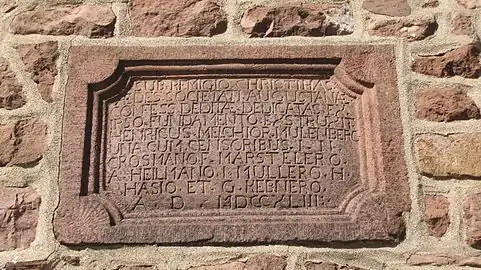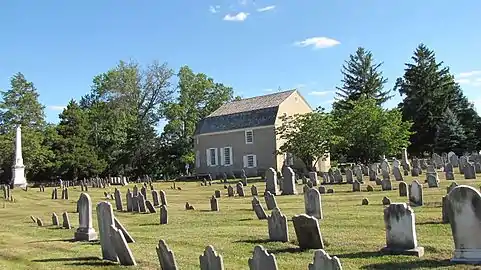Augustus Lutheran Church
Augustus Lutheran Church is a historic church and Lutheran congregation at 717 West Main Street in Trappe, Pennsylvania. Consecrated in 1745, it is the oldest Lutheran church building in the United States.[4] It continues to be used by the founding congregation for services during the summer. It was designated a National Historic Landmark in 1967.[2]
Augustus Lutheran Church | |
.jpg.webp) Augustus Lutheran Church | |
  | |
| Location | 717 Main Street, Trappe, Pennsylvania |
|---|---|
| Coordinates | 40.2019°N 75.4805°W |
| Built | 1743 |
| Architect | Heinrich Melchior Muhlenburg |
| NRHP reference No. | 67000019[1] |
| Significant dates | |
| Added to NRHP | December 24, 1967[1] |
| Designated NHL | December 24, 1967[2] |
| Designated PHMC | September 03, 1947[3] |
History
The Trappe area was settled by Germans in 1717, who worshipped informally or under itinerant preachers until the arrival of Heinrich Melchior Mühlenberg in 1742. Their first church, which cost 200 pounds sterling, was designed by Mühlenberg. All of the interior fittings were fabricated from local materials, including the pulpit which is made of American black walnut. The building is constructed of red sandstone (now faced with stucco); the east end of the building is formed into a three-sided apse. Above the south entrance is a date stone inscribed in Latin with the names of the church's founders, including Henry Melchior Muhlenberg, Frederick Marsteller, John Nicholas Cressman, Anthony Heilman (Hallman), Jacob Miller, Henry Haas, and George Kebner. The roof is framed with oak rafters and covered in cedar shingles. The cemetery at the rear of the building contains tombstones dating from 1736 and earlier, as well as the graves of Henry Melchior Muhlenberg, his wife Anna Maria Weiser, and their daughter Mary Swaine and son General Peter Muhlenberg.[5]
Although the shell of the building was finished in 1743, the church was not consecrated until 1745. It was named after August Hermann Francke, founder of the Francke Foundations in Halle, Germany, a center of Lutheran Pietism where Henry Melchior Muhlenberg had trained. During the American Revolution, the building was used as a camping site and hospital for the Continental Army. A monument at the west end of the church commemorates unknown Revolutionary War soldiers buried in the cemetery.
By the mid-1800s, the congregation had outgrown the old building, and a new brick church was built. This structure was consecrated in 1852, whereupon the old building became used for Sunday School classes. A freak thunderstorm in 1860 severely damaged the roof; however, it was decided to restore the building rather than tear it down. A cast-iron stove was then added to the previously unheated building. Renovations in the 1920s restored the building to its original appearance. In the late 1950s, services were once again held in the Old Church in the summer and on Christmas Eve, a tradition which continues to the present day. A digital organ was placed in the original organ case in the early 1990s.
The church was declared a National Historic Landmark in 1967.[2][4]
 Datestone in Latin
Datestone in Latin Grave of Henry M. Muhlenberg
Grave of Henry M. Muhlenberg Pulpit in 1919
Pulpit in 1919 Cemetery and church
Cemetery and church
See also
References
- "National Register Information System". National Register of Historic Places. National Park Service. July 9, 2010.
- "Augustus Lutheran Church". National Historic Landmark summary listing. National Park Service. Archived from the original on 2011-06-06. Retrieved 2007-11-08.
- "PHMC Historical Markers". Historical Marker Database. Pennsylvania Historical & Museum Commission. Archived from the original on December 7, 2013. Retrieved December 30, 2013.
- Patricia Heintzelman and Charles Snell (August 30, 1974). "National Register of Historic Places Inventory-Nomination: Augustus Lutheran Church" (pdf). National Park Service. Cite journal requires
|journal=(help) and Accompanying 3 National Park Service photos, exterior, from 1967. (970 KB) - Minardi, Lisa. Pastors & Patriots: The Muhlenberg Family of Pennsylvania (Collegeville, PA: Berman Museum of Art, 2011), p. 10-11.

